
Abimelech was the generic name given to all Philistine kings in the Hebrew Bible from the time of Abraham through King David. In the Book of Judges, Abimelech, son of Gideon, of the Tribe of Manasseh, is proclaimed king of Shechem after the death of his father.

England became inhabited more than 800,000 years ago, as the discovery of stone tools and footprints at Happisburgh in Norfolk have indicated. The earliest evidence for early modern humans in Northwestern Europe, a jawbone discovered in Devon at Kents Cavern in 1927, was re-dated in 2011 to between 41,000 and 44,000 years old. Continuous human habitation in England dates to around 13,000 years ago, at the end of the Last Glacial Period. The region has numerous remains from the Mesolithic, Neolithic and Bronze Age, such as Stonehenge and Avebury. In the Iron Age, all of Britain south of the Firth of Forth was inhabited by the Celtic people known as the Britons, including some Belgic tribes in the south east. In AD 43 the Roman conquest of Britain began; the Romans maintained control of their province of Britannia until the early 5th century.

The House of Tudor was a dynasty of largely Welsh and English origin that held the English throne from 1485 to 1603. They descended from the Tudors of Penmynydd and Catherine of France. Tudor monarchs ruled the Kingdom of England and its realms, including their ancestral Wales and the Lordship of Ireland for 118 years with five monarchs: Henry VII, Henry VIII, Edward VI, Mary I and Elizabeth I. The Tudors succeeded the House of Plantagenet as rulers of the Kingdom of England, and were succeeded by the House of Stuart. The first Tudor monarch, Henry VII of England, descended through his mother from a legitimised branch of the English royal House of Lancaster, a cadet house of the Plantagenets. The Tudor family rose to power and started the Tudor period in the wake of the Wars of the Roses (1455–1487), which left the main House of Lancaster extinct in the male line.

Charles IV, also known as Charles of Luxembourg, born Wenceslaus, was the first King of Bohemia to become Holy Roman Emperor. He was a member of the House of Luxembourg from his father's side and the Bohemian House of Přemyslid from his mother's side; he emphasized the latter due to his lifelong affinity for the Bohemian side of his inheritance, and also because his direct ancestors in the Přemyslid line included two saints.
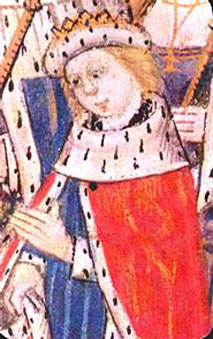
Edward V was de jure King of England from 9 April to 25 June 1483. He succeeded his father, Edward IV, upon the latter's death. Edward V was never crowned, and his brief reign was dominated by the influence of his uncle and Lord Protector, the Duke of Gloucester, who deposed him to reign as King Richard III; this was confirmed by the Act entitled Titulus Regius, which denounced any further claims through his father's heirs.
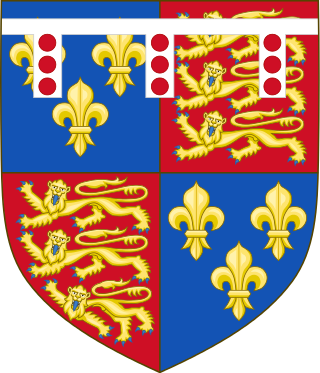
The House of York was a cadet branch of the English royal House of Plantagenet. Three of its members became kings of England in the late 15th century. The House of York descended in the male line from Edmund of Langley, 1st Duke of York, the fourth surviving son of Edward III. In time, it also represented Edward III's senior line, when an heir of York married the heiress-descendant of Lionel, Duke of Clarence, Edward III's second surviving son. It is based on these descents that they claimed the English crown. Compared with its rival, the House of Lancaster, it had a superior claim to the throne of England according to cognatic primogeniture, but an inferior claim according to agnatic primogeniture. The reign of this dynasty ended with the death of Richard III of England at the Battle of Bosworth Field in 1485. It became extinct in the male line with the death of Edward Plantagenet, 17th Earl of Warwick, in 1499.

Locrinus was a legendary king of the Britons, as recounted by the 12th-century chronicler Geoffrey of Monmouth in his Historia Regum Britanniae.
Mempricius was a legendary king of the Britons, as recounted by Geoffrey of Monmouth. He was the son of King Maddan and brother of Malin.
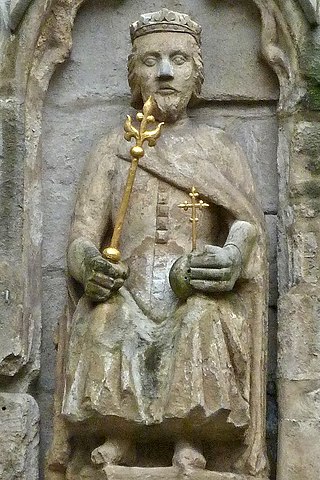
Belinus the Great was a legendary king of the Britons, as recounted by Geoffrey of Monmouth. He was the son of Dunvallo Molmutius and brother of Brennius. He was probably named after the ancient god Belenus.

Brennius was a legendary king of Northumberland and Allobroges, as recounted by Geoffrey of Monmouth. He was the son of Dunvallo Molmutius and brother of Belinus, probably based upon one or both of the historical Brenni.
Morvidus was a legendary king of the Britons from 341 to 336 BCE., as recounted by Geoffrey of Monmouth. He was the illegitimate son of Danius by his mistress Tangustela.
Archgallo was a legendary king of the Britons as recounted by Geoffrey of Monmouth. He was the second son of King Morvidus and brother of Gorbonianus.
Ingenius is a legendary king of the Britons as recounted by Geoffrey of Monmouth's pseudohistorical work Historia Regum Britanniae, written c. 1138 CE. Ingenius was the fourth son of King Morvidus and the brother of Gorbonianus, Archgallo, Elidurus, and Peredurus.
Enniaunus was a legendary king of the Britons as recounted by Geoffrey of Monmouth. He was the son of King Archgallo and brother of Marganus II. According to Geoffrey, he ruled poorly and harshly causing him to be deposed due to tyranny. He was replaced with his cousin, Idvallo.
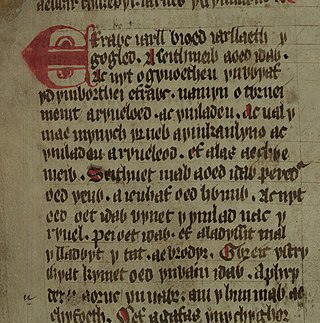
Peredur is the name of a number of men from the boundaries of history and legend in sub-Roman Britain. The Peredur who is most familiar to a modern audience is the character who made his entrance as a knight in the Arthurian world of Middle Welsh prose literature.
Gorbonianus was a legendary king of the Britons as recounted by Geoffrey of Monmouth. He was the eldest son of King Morvidus, and the brother of Archgallo, Elidurus, Ingenius, and Peredurus.
Peredurus is a legendary king of the Britons in Geoffrey of Monmouth's pseudohistorical chronicle Historia Regum Britanniae. According to Geoffrey, he was the youngest son of King Morvidus and brother of Gorbonianus, Archgallo, Elidurus, and Ingenius.
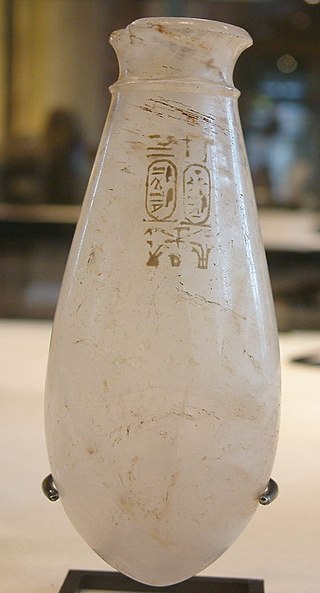
The Twenty-third Dynasty of Egypt is usually classified as the third dynasty of the ancient Egyptian Third Intermediate Period. This dynasty consisted of a number of Meshwesh kings, who ruled either as pharaohs or as independent kings of parts of Upper Egypt from 880 BC to 720 BC, and pharaohs from 837 BC to 728 BC.

Carisbrooke is a village on the south western outskirts of Newport, Isle of Wight and is best known as the site of Carisbrooke Castle. It also has a medieval parish church. St Mary's Church, began life as part of a Benedictine priory, established by French monks about 1150. The priory was dissolved by King Henry V of England in 1415 during the French Wars. Neglect over the centuries took its toll, but in 1907 the church was restored to its full glory. Its most striking feature is the 14th century tower, rising in five stages with a turret at one corner and a battlemented and pinnacled crown.

The Kingdom of Brittany was a short-lived vassal-state of the Frankish Empire that emerged during the Norse invasions. Its history begins in 851 with Erispoe's claim to kingship. In 856, Erispoe was murdered and succeeded by his cousin Salomon.











